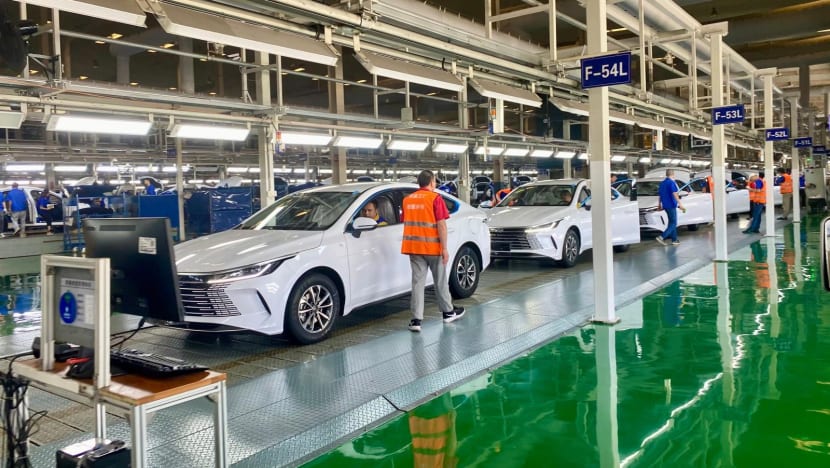What you should know about Changsha, known as China’s entertainment capital
As China marks the 75th anniversary of the People’s Republic this year, Changsha is among the nation’s central cities that have gone from relative obscurity to becoming integral to its development.

Tourists with a statue of China’s late founding leader Mao Zedong in Changsha in the country's central region. (Photo: CNA/Olivia Siong)

This audio is generated by an AI tool.
CHANGSHA, Hunan: Leaving the bustling financial hub of Shanghai for the lesser-known city of Changsha in central China’s Hunan province may appear to be a step backwards to some, but not for one young couple.
Ms Shi Honghong, 29, and her husband Xie Chaofeng, 30, made the bold move about three years ago. Today, they have no regrets.
Shanghai, classified as a first-tier Chinese city along with Beijing, Shenzhen and Guangzhou, is a “prosperous city" that many Chinese aspire to live in, said Ms Shi.
But while income levels in Shanghai may be higher, Ms Shi also noted that the high housing prices in the city were one of the main push factors, especially as she and her husband looked to start a family.
The couple recently moved into their new 120 sqm home in the Changsha suburbs, bought for about US$225,000, about a fifth of what they would have have to pay in Shanghai.
The affordable housing in Changsha has been a key draw for many who have relocated to the city. Prices are kept in check as the local government unlike many others, does not rely on land financing and real estate for revenue.
THE APPEAL OF CHANGSHA
The couple said they were also drawn by the better quality of life that Changsha appeared to offer.
“Rather than just existing in a city, truly living in the city is the more important thing,” she told CNA.
“Compared to Shanghai, Changsha has a more down-to-earth atmosphere with a vibrant everyday life, and the pace of life is more relaxed. Although there may still be some overtime work, it's easier to find a balance between work and life.”
The couple is among a growing number relocating to the city.
In the last three years, cities in China’s central region have seen the strongest population growth. Changsha took the top spot in 2022, while Hefei, the provincial capital of neighbouring Anhui, came in tops last year.
As China marks the 75th anniversary of the People’s Republic this year, Changsha is among the nation’s central cities that have gone from relative obscurity to becoming integral to China’s development.
“We already see that many of the first- or second-tier cities in the coastal areas already reached a kind of growth limit in terms of population, in terms of economic development,” said Dr Chen Gang, deputy director of the East Asian Institute at the National University of Singapore.
“But for the second- and third-tier cities in the inland provinces, there is huge development room and space for them because the population are refocusing in those areas and there's very strong technological and industrial clustering conditions to support their future developments.”

CHANGSHA’S CLAIM TO FAME
Changsha’s appeal comes from several factors.
In the Milken Institute’s recent report on the best-performing Chinese cities, Changsha was ranked fourth and among four cities in central China that made it to the top 10 list.
The report added that it distinguished itself by claiming the top spot for having the highest average one-year and five-year employment growth amongst all first- and second-tier cities.
It was also ranked in the top 10 based on other metrics used, including growth in foreign enterprise share and expansion in public expenditure devoted to science and technology.

Changsha’s other claim to fame is that China’s late founding leader Mao Zedong got his revolutionary start there, studying in the city during his formative years.
His hometown of Shaoshan, also in Hunan province, is situated about a 100km from Changsha.
A 32m-tall statue of him as a youth standing on an island in the centre of Changsha is now a popular tourist attraction.
The city has also made its mark as a regional powerhouse in industries ranging from heavy construction machinery to smart manufacturing.
It is also known as the nation’s entertainment capital, as home to the provincial television network which has produced numerous popular variety and talent shows.
Also calling Changsha home is Chinese electric vehicle giant BYD. Based in Changsha since 2009, BYD put the city on the map and has continued to expand with strong local government support.
As a testament to its success, Changsha has so far attracted more than 200 Fortune Global 500 companies to its shores. But the city is not all work and no play. Known also for its bustling night life, it has ranked among the top 10 happiest cities in China for 16 years straight.

However, Changsha did not always enjoy such a lively reputation.
The development of China’s central region lagged behind others' during the country’s reform and opening up era in the 80s and 90s, as resources were focused on booming coastal cities.
That situation changed partly due to better government policies, under what was dubbed the “rise of central China” plan, first mooted by then Chinese Premier Wen Jiabao in 2004.
Favourable central government policies for the six inland provinces of Hunan, Hubei, Henan, Shanxi, Anhui and Jiangxi included the removal of investment restrictions and better tax treatment.
Changsha seized opportunities to develop pillar industries, entering the prized trillion yuan gross domestic product (GDP) club and earning its “new first-tier city” status in 2017.
“You don't get to be in this kind of competitive instant position overnight,” said business expert John Quelch, who is an executive vice-chancellor at Duke Kunshan University.
“It's a result of decades of work by many, many government officials and industrial executives with very high entrepreneurial ambition for the city.”
THE CENTRAL REGION’S ECONOMY
Changsha is among the cities that have branded themselves as allowing for a relaxed pace of life, said Milken Institute’s managing director of research Perry Wong.
“It (such branding) created a big wave of new policy (and) new thinking by not just providing convenience to businesses, but also attracting young talent to the city,” he told CNA’s East Asia Tonight.
“They figured (that) once you have the young people, companies will likely be following those young talents as well.”
The central region’s GDP reached US$3.7 trillion last year, accounting for about a fifth of the country’s total GDP.
However, the pace of the region’s growth has lagged behind all other Chinese regions, except the northeast.

Last year, its GDP expanded by 4.9 per cent, below the country’s overall growth rate of 5.2 per cent.
“After the pandemic, or even during the pandemic, actually much of the foreign investments started to leave some of the central provinces due to the strict COVID restrictions and also the increase in cost and the international context of decoupling and de-risking,” said Dr Chen.
Chinese President Xi Jinping at a meeting in Changsha earlier this year acknowledged there are challenges to be addressed and called for “solid efforts” to further energise the central region.
This comes as China’s economy has continued to face headwinds, amid doubts over whether it can meet its GDP growth target of around 5 per cent this year.
“Changsha is, in a sense, a hub for the central region and especially in the automotive sector, and obviously attracts many resources and companies to the region,” said Dr Quelch.
He added, however, it is important that the surrounding region also benefits from the city’s success.
“You don't want the entire economy of the region to be as if it was sucked into the vortex of that single city; you want the wealth to be spread around the entire region, and that's often a challenge,” he said.


















